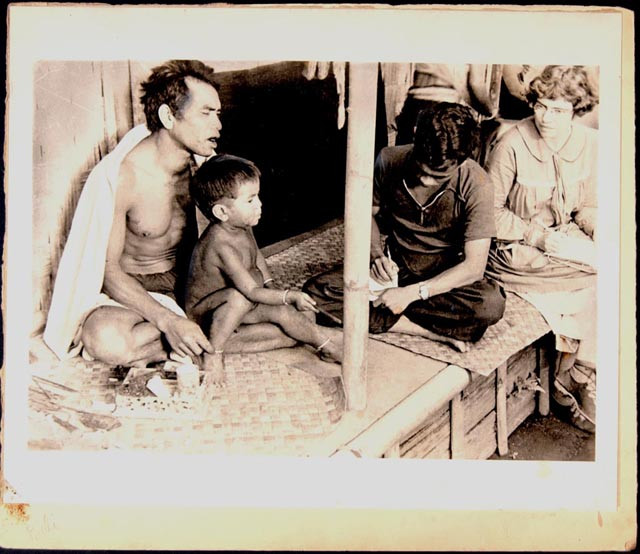Popular Reads
Top Results
Can't find what you're looking for?
View all search resultsPopular Reads
Top Results
Can't find what you're looking for?
View all search resultsBaby-led weaning approaches learning through food, for mothers and infants
Baby-led weaning is the latest parenting trend making its rounds on social media, despite the feeding method's departure from traditional ones, in that it skips spoon-feeding entirely and allows babies to discover and eat foods on their own. Here are two mothers' experiences in applying the method.
Change text size
Gift Premium Articles
to Anyone
 Learning by eating: A montage shows Cosmo (left), 7 months, and Eileen (right), 18 months, eating on their own. Angela Valerie introduced baby-led weaning (BLW) to her second-born Cosmo when he was 6 months old, while Ella Setiamiharja introduced the self-feeding method to daughter Eileen (right) when she was 4.5 months old. (Personal collection/Courtesy of Angela Valerie and Ella Setiamiharja)
Learning by eating: A montage shows Cosmo (left), 7 months, and Eileen (right), 18 months, eating on their own. Angela Valerie introduced baby-led weaning (BLW) to her second-born Cosmo when he was 6 months old, while Ella Setiamiharja introduced the self-feeding method to daughter Eileen (right) when she was 4.5 months old. (Personal collection/Courtesy of Angela Valerie and Ella Setiamiharja)
It's easy to nominate mealtime as the favorite time of the day. But for parents with infants, mealtimes could be the least favorite time of day, especially if their babies refuse to eat.
Over the last 10 years, however, the internet has become swamped with pictures and videos of babies grabbing their own food and putting it into their mouths with gusto. This alternative approach to feeding infants, known as self-feeding or baby-led weaning (BLW), has sparked debate between parents who think the method is wrong and those who think it is good.
With parents joining the rise in sharing on social media by uploading photographic and video documentation of their kids feeding themselves, BLW has become the latest hot topic in Indonesia.
The comments section of one TikTok video, showing 8-month-old Cosmo eating chicken drumsticks enthusiastically, is flooded with varying responses. Some users convey doubt or disagreement over the method with comments like, "Isn't that dangerous?" and "My husband would be infuriated if I fed my kid this way," while other responses have a more supportive tone.
Cosmo's 34-year-old mother, Angela Valerie, decided to jump on the BLW bandwagon from the difficulties she experienced when trying to feed solids to her firstborn, Coral, now 4.
"I think one of the many milestones in parenting is introducing solid [food] to our kids. Growing up, my first son was a very picky eater. It was hard to make him eat something other than chips and nuggets. He only eats what he knows,” recalled Angela, who works as a creative director in Bali.
“I have no nanny so it was frustrating, and I don't think I could handle a second picky child," she said. So Angela has gone down a different route in introducing solids to her second son.
Eating as adventure
Mealtimes in Angela’s household are simple. Cosmo sits in a high chair and Angela places his meals on the attached dining tray. Her direct involvement stops there. Cosmo can then freely decide which food he wants to eat and how much, under his mother’s watchful gaze.
Despite the family members who question the method, Cosmo has already demonstrated that he is an advanced eater.
"There was one time when Cosmo was not even eight months old. He was eating [a slice of] watermelon. He bit [the rind], but then realized it was too hard for him, so he turned the watermelon the other way [around] and ate the flesh," Angela said. "Isn't it amazing how Cosmo knew where to bite? If you let a baby do his own thing, you’ll be surprised at how smart they are."
BLW is said to have many promising benefits, such as fostering independence, developing critical motor and chewing skills, and helping infants learn when they are full.
Ella Setiamiharja, a Bandung-based pilates instructor, decided to go full BLW and share her experience on Instagram under the handle @diaryofeileens. It all started during her time in Sydney, where she saw her peers implementing the BLW method in feeding their children.
"In Indonesia, there's the term gerakan tutup mulut [mouth shut movement] for children who refuse to eat for, like, a week. It shows that Indonesian mothers are already familiar with this tendency among children," said Ella.
Unlearning cultural influences
What does the growing trend in BLW indicate about Indonesian parenting styles?
Both Ella and Angela concluded separately that the traditional methods of “force-feeding” or using negative reinforcement when feeding children contributed to shaping the local BLW trend.
Angela said that when she was a child, her father would punish her if she didn't finish her food, such as by putting on chili oil on her lips. "That was quite a traumatic experience," she said.
As for Ella, whenever she's dining out, she dislikes seeing mothers shoving spoonfuls of food into their children’s mouth. Although culture plays a part in child rearing and isn’t for anyone to judge, Ella feels she would be irritated if she was the baby.
How children perceived mealtimes could be seen in their body language, noted Angela, who hadn’t decided whether to apply the BLW method when starting Coral on solids because of the limited research available.
"If I compare Coral and Cosmo, Coral doesn't like to eat because it's full of pressure. There's always yelling, there's always resistance. With Cosmo, he's always smiling," she said.
Skipping the step of spoon-feeding pureed foods is said to benefit both babies and mothers and their developing relationship. Ella and Angela both said they got to know their babies better through their BLW journey and that their respect for their children grew on the understanding they gained.
"I learned that babies aren't that fragile and [that] they show their problem-solving skills at a very young age,” said Ella. “When my daughter Eileen gags, she always knows how to spit out her food or wash it down with water without my help. I just watch and guide her." Now 22 months, Ella used BLW to introduce Eileen to solid foods at just four and a half months old.
Dietitian and feeding therapist Leona Victoria said that BLW was recognized by the Indonesian Pediatric Society (IDAI) for its benefits as a responsive feeding method.
"BLW is based on the child’s hunger, thirst and satiety cues, which can rarely be practiced with the traditional spoon-fed [method]," Leona told The Jakarta Post, although she said that both methods had their pros and cons.
Of particular note was keeping an eye on nutritional intake. "BLW depends solely on the child, but sometimes what they eat might not be sufficient for their growth," she said.
Downside to BLW
The BLW feeding method, which was pioneered in the United Kingdom by former nurse Gill Rapley and coauthor Tracey Murkett in 2009 with Baby-led Weaning: Helping Your Baby To Love Good Food, might not be for every mother.
"It takes a lot of planning on top of anxiety as well. Seeing your kid gag is not a pretty sight. And maybe one of the biggest turnoffs is the mess,” said Angela. “With what I'm getting, seeing Cosmo and his relationship with food, how adventurous he is with food, I’m happy to pay that price."
BLW’s child-centered approach is similar to the Montessori method, an educational method that Angela is leaning toward for its emphasis on self-learning.
"[Children] are their own entity, and they have full autonomy, too. If you let them, they will surprise you again and again,” she said. “Sometimes without our realizing, we, as [their] parents, are the ones that are limiting their capabilities."
Disclaimer: This is a general article and does not represent the views or stance of The Jakarta Post. Seeking the advice of a licensed doctor is highly recommended before starting a new parenting, health or beauty regimen.












